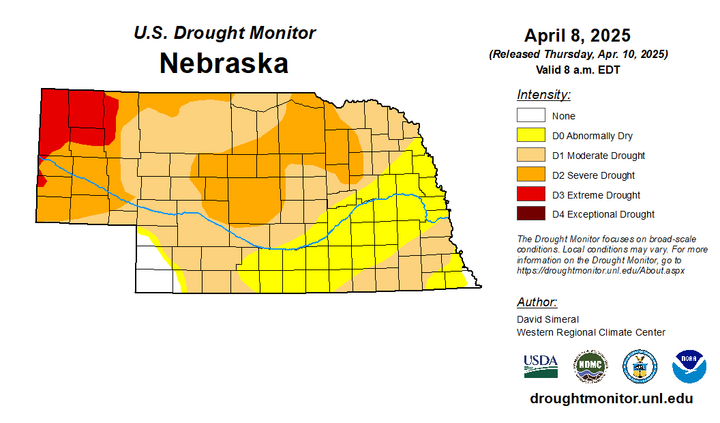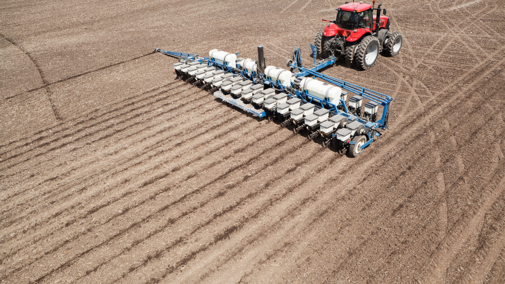As of April 3, 2025, the Nebraska Drought Monitor shows 76% of Nebraska in moderate to exceptional drought (D1-D4), compared to 55% a year ago. Planting sets the stage for everything else that happens during the growing season. This article highlights key UNL planting recommendations and offers additional considerations for planting into dry conditions.

Agronomic Considerations
Soil Conditions
This is perhaps the most critical component to planting because soil conditions set the stage for the decisions we make regarding planter adjustments, which crop is planted and planting depth. Some areas of the state received some fall/winter/spring precipitation to help with replenishing soil moisture, while other areas continue to lack subsoil moisture due to lack of precipitation events.
While subsoil moisture recharge during the off season is critical for crop production — especially in non-irrigated cropping systems — the soil surface moisture, or lack off, where seed is going in the ground is critical for planting. The planting months of April-May-June are between the months with large average rainfall during the year in Nebraska with a greater number of rainy days. This means that despite subsoil conditions, managing rapid changes in surface moisture at planting can become challenging.
When planting into drier conditions, increased down pressure is most likely necessary; however, be careful of causing any sidewall compaction. In many cases, increasing pressure won’t be reflected in planting quality. It is important to check on the planting monitor the “as applied” down pressure. There are cases in which extra weights are needed on the planter to make the extra down force work. With excess moisture, it's important to wait and avoid compaction and ensure the seed vee closes. If surface moisture conditions change rapidly from dry to wet or wet to dry, remember to readjust your down pressure to the actual planting conditions.
Soil Moisture, Temperature and Planting Depth
Corn needs to absorb 35% of its weight in moisture to complete the imbibition (water uptake) phase of germination. When adequate soil moisture is available, this typically occurs within 48 hours. Soybean needs to absorb 50% of its weight in moisture to complete the imbibition process. When adequate soil moisture is available, recent research has shown imbibition can occur anywhere from eight to 24 hours. Once imbibition has occurred, soybean seeds enter an osmotic phase and are quite tolerant of soil temps as low as 35-40°F, although extended low soil temperatures can be expected to lengthen the germination to emergence timeframe.
In general, we’d recommend planting into soil temperatures as close to 50°F as possible and when the forecast is calling for warm air temperatures the next few days, as that would also help increase the soil temperature. Avoid planting prior to a cold snap (cold rain/snow) within eight to 24 hours for soybean and 48 hours for corn. You can take soil temperatures using a thermometer or you can view soil temperatures on CropWatch. Also be aware that soil moisture can help buffer soil temperatures, reducing larger swings, whereas dryer soils can cool down much quicker. If soil temperature can compromise emergence, why do we keep pushing early planting, especially for soybean? It is because of the yield advantage shown in the following article: Retrospective analysis of Nebraska corn and soybean planting progress (1980-2022).
How does soil moisture impact planting depth? Research has consistently shown the need for corn to be planted two inches deep. UNL showed best soybean yields were obtained by planting at a 1.75-inch depth. So, the short answer — aiming for close to two inches is a good consideration for both corn and soybean. Planting shallower than 1.5 inches leads to more impacts on root development in corn, such as rootless corn syndrome. Proper seeding depth for soybean helps keep that seed in buffered soil moisture and temperature when planted early. It also aids that seedling from emerging too early.
Ensuring good soil-seed contact is key to emergence success. When seeds fall into an air pocket or rows are not well closed, the imbibition phase can be interrupted or never occur. We advise digging up some seeds during planting to check for proper seed-soil contact, moisture around the seed, and adjusting the planter as needed.
Uniform emergence is more important for corn than soybean. Because of this, Rob Nielsen, emeritus extension agronomist at Purdue shares, “When seedbed conditions are dry, make sure you choose a seeding depth that ensures uniformly adequate soil moisture for (corn) germination and emergence. Even though a 1.5- to 2-inch seeding depth is a good choice for many conditions, do not hesitate to increase seeding depth to 2.5 or 3 inches if that is the depth where uniform soil moisture is located.” We did have growers planting down to 3.5” in Nebraska in 2023 and 2024 to get even depth to moisture and the corn still came up. When it comes to soybean, we wouldn’t recommend planting much deeper than 2.5 inches.
For corn seeding rates, it’s best to check with your local seed dealer as our research shows that optimal corn population varies by hybrid. For those concerned about moisture in non-irrigated or limited-irrigated situations, one may consider using a hybrid with higher flex at a reduced seeding rate.
For soybean, our recommendation after 18 years of on-farm research studies (2006-2024) in heavier textured soils and 30-inch rows continues to be: plant 120,000 seeds/acre, aim for a final plant stand of 100,000 plants/acre and you’ll save money without reducing yields. If that’s too scary, try reducing your rate to 140,000 seeds/acre or try testing it for yourself via on-farm research.
Herbicide Considerations
PPO inhibitors are an effective chemistry often used for pre-emergence applications in soybean. The different PPO-inhibiting active ingredients, products and timing restrictions can be reviewed in this article. Soybean injury can occur in situations where the seed/germinating seed comes in contact with the PPO-inhibiting herbicide and via water splash onto the emerged soybean hypocotyl and cotyledons.
Some considerations to reduce injury to soybean include:
- Do NOT apply a PPO inhibitor herbicide if the seed vee is not closed, the soil is cracking along the seed trench or the soybean is beginning to emerge or has already emerged. Another option if one is concerned about PPO inhibitor injury is to consider using Group 15 herbicide such as acetochlor (Warrant), pyroxasulfone (Zidua), dimethenamid-P (Outlook), etc. for residual weed control in a post-emergence application once the soybean has emerged. Remember that residual herbicides applied post-emergence do not have foliar activity, so they will not control emerged weeds but would prevent the emergence of new weeds.
- Do not plant soybean shallow (less than 1.5 inches), particularly if the soil at seeding depth is dry. If a PPO inhibitor is applied in these conditions, it can allow the soybean to imbibe water with the herbicide in it, particularly if a rain and/or irrigation event occurs after application.
- If soybean is planted into moisture, herbicide can be applied within a few days and watered in as long as the seed vee is closed and no soil cracking of the trench is occurring.
Irrigation Considerations
Irrigating Prior to Crop Planting
In general, we would only suggest watering before planting if the planter needs higher soil moisture levels to work well. If the soil is excessively hard, powdery or cloddy, running the pivot before planting may be beneficial. Another scenario to consider pre-watering is when more than 180 lb/ac of anhydrous ammonia has been applied in strips, and less than 2 inches of moisture have been received since application — this can help minimize ammonia burn to the corn. Otherwise, we recommend running the pivot after planting and only if needed.
Irrigation Considerations Early in the Year
Running center pivots early in the season do have some extra challenges. First, keep in mind cold nights. The usual recommendation is not to run a pivot when temperatures are below 40°F. The past few years, several pivots operated below 40°F without problem, but keep in mind with low dewpoints, the pivot can ice up when the actual air temperature is well above 32°F. So, if you do choose to run in these conditions, keep a close eye out for ice buildup.
Second, bare, powdery soils tend to seal quickly after rain or irrigation, so monitor closely for runoff, even with minimal water application.
Third, when irrigating, ensure you apply enough water to reach the moist soil layer beneath. This issue is especially common following cover crops, tillage or fertilizer knife operations, which often leave the soil excessively dry. In other words, if a field has 4 or 5 inches of dry soil and a small rain or irrigation only moves water to 3 inches, the seedling can get started but will die from lack of moisture because roots cannot grow through dry soil.
Irrigating for Herbicide Activation
It’s important that herbicides are activated with 0.5- to 0.75-inch rainfall or irrigation, preferentially within five to seven days after herbicide application. If moisture received is less than this amount, some herbicide products have the potential to remain on the soil for up to 14 days without being fully activated. We will have to see how the high winds blowing soil and removing soil particles containing herbicide impact future weed control.
Irrigating to Reduce Nitrogen Loss
When dry or liquid urea is surface-applied without the use of a nitrogen stabilizer, applying approximately 0.5-inch of irrigation can help incorporate the fertilizer into the soil and reduce the potential for nitrogen loss.
In situations where irrigation is not available, no inhibitor was used, and no rainfall has occurred within seven days of application, it is important to monitor the corn crop for signs of nitrogen deficiency. Nitrogen losses under these conditions can occur early and be substantial, especially in fields with high surface crop residue, elevated soil temperatures above 70°F, moist conditions, high soil pH levels (greater than 7.0), or sandy textures.
In contrast, losses tend to be lower when soils are dry and temperatures are cooler. Timely incorporation through irrigation or rainfall is critical to preserving nitrogen availability for crop uptake.
Irrigating in Strip-till
Regardless of whether anhydrous was applied in the fall or spring, and regardless of amount applied, ammonia burn may occur due to the dry conditions. Sometimes ammonia burn is seen early with seed germination and emergence. Most often, it is seen when roots get to 4-8 inches long and hit the ammonia band. Irrigation can help alleviate the impacts of the ammonia injury.
Irrigating and Cold Water Impacts
John Mick, Pioneer agronomist, shared that water from irrigation wells in the southern part of the state often is around 50-53°F, with it slightly less in temperature as one moves north in the state. These temperatures are not a problem to be concerned with regarding any negative impacts to seeds imbibing water.
Each field situation will vary, and we hope these considerations will help as you begin or continue this year’s planting season!
References
Jhala, Amit. June 5, 2017. PPO Inhibiting Herbicides and Soybean Seedling Injuries. https://cropwatch.unl.edu/2017/ppo-inhibiting-herbicides-and-soybean-seedling-injuries
Jhala, Amit. April 22, 2020. Timing is Critical for Applying PPO-Inhibiting Pre-emergence Residual Herbicides in Soybean. https://cropwatch.unl.edu/2020/timing-critical-applying-ppo-inhibiting-pre-emergence-residual-herbicides-soybean
Jhala, Amit. May 31, 2023. Soil residual herbicide options after soybean emergence. Crop Watch. https://cropwatch.unl.edu/2020/soil-residual-herbicide-options-after-soybean-emergence/
Mick, John. April 15, 2022. Pioneer Agronomy Season Update. https://drive.google.com/file/d/1QE7PpVDIe0HTbwRAuyrpH7E8JhHjN6Y1/view
Nielsen, R.L. (Bob). April 2020. Requirements for Uniform Germination and Emergence of Corn. https://www.agry.purdue.edu/ext/corn/news/timeless/GermEmergReq.html
Rees, Jenny, Roger Elmore, Jim Specht, Megan Taylor. April 22, 2020. Corn and Soybean Planting Considerations for 2020. https://cropwatch.unl.edu/2020/corn-and-soybean-planting-considerations-2020
Rees, Jenny and Jim Specht. April 9, 2020. Understanding the Soybean Germination Process for Early Planted Soybean Decisions. https://cropwatch.unl.edu/2020/understanding-soybean-germination-process-early-planted-soybean-decisions
Rees, Jenny and Jim Specht. April 14, 2021. Demonstrating Critical Imbibitional Time for Soybean. https://cropwatch.unl.edu/2021/demonstrating-critical-imbibitional-time-soybean
Specht, Jim, Jenny Rees, Nicolas Cafaro La Menza, Patricio Grassini, and Tom Hoegemeyer. May 4, 2023. A Retrospective Analysis of Nebraska Corn and Soybean Planting Progress (1980-2022). https://cropwatch.unl.edu/2023/retrospective-analysis-nebraska-corn-and-soybean-planting-progress-1980-2022/
Specht, Jim, Jenny Rees, Keith Glewen, Patricio Grassini. April 30, 2014. Soybean Planting Depth: Consider Planting Deeper. https://cropwatch.unl.edu/soybean-planting-depth-consider-planting-deeper

